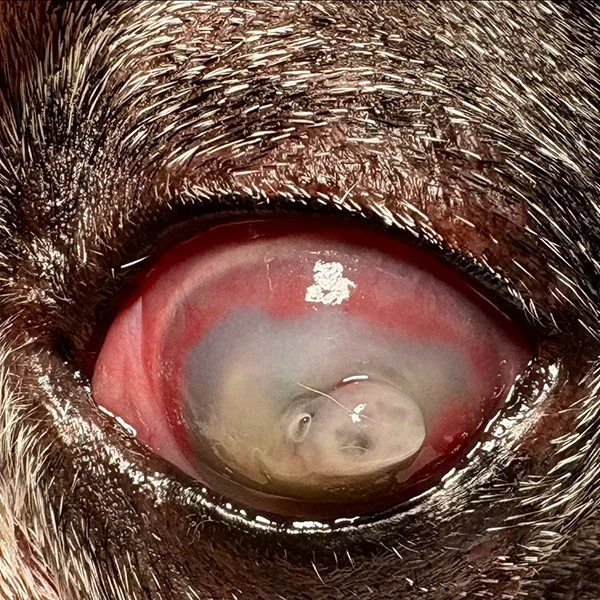Pet Corneal Perforations in Spring, TX
North Houston Veterinary Ophthalmology handles comprehensive care for pet corneal perforations in Spring, TX, treating your companions with expert diagnoses, tailored treatments, and compassionate follow-ups.

Pet Corneal Perforations
Understanding Pet Corneal Perforations
Pet corneal perforations are serious eye conditions that can cause significant discomfort and vision loss in pets. At North Houston Veterinary Ophthalmology, we specialize in diagnosing and treating these conditions to ensure your furry companions can enjoy a higher quality of life with strong, unclouded vision.

What is a Corneal Perforation?
A corneal perforation occurs when a corneal defect extends through the full thickness of the cornea, leading to a rupture of the globe. This condition can be particularly distressing for pets, as the cornea is crucial for focusing vision.
Clinical Signs of Corneal Perforations
Recognizing the clinical signs of corneal perforations is essential for timely treatment. Symptoms include:
- Squinting or keeping the affected eye closed
- Rubbing the eye with paws or against surfaces
- Avoidance of touch near the affected area
- Ocular discharge or bleeding
- Redness and cloudiness of the eye
- Presence of a “mass” on the cornea
These symptoms indicate significant discomfort and potential vision impairment, necessitating prompt veterinary attention.
Causes of Corneal Perforations
Corneal perforations typically result from untreated or severe corneal ulcers. These ulcers can penetrate the cornea’s full thickness, approximately 0.5mm, leading to perforation. Depending on underlying conditions and factors such as trauma or infections, this progression can occur rapidly within hours or slowly over weeks to months.
Treatments for Corneal Perforations
Addressing corneal perforations requires surgical intervention to repair the structural damage. Various grafting procedures are available to correct the defect and restore the eye’s integrity. At North Houston Veterinary Ophthalmology, our expert team evaluates each case to determine the most appropriate surgical approach.
In most cases, early detection and treatment can save the eye and restore vision. However, if the damage is extensive or the condition is chronic, enucleation (removal of the eye) may be necessary to prevent further pain and complications.
Why Choose North Houston Veterinary Ophthalmology?
At North Houston Veterinary Ophthalmology, we are dedicated to providing comprehensive eye care for pets in Spring, TX and the surrounding area. Our specialized services for pet corneal perforations include:
- Expert Diagnosis: Advanced diagnostic tools to accurately identify corneal perforations and underlying causes.
- Tailored Treatment Plans: Customized surgical and medical treatments to suit each pet’s specific needs.
- Experienced Veterinary Ophthalmologists: Skilled professionals with extensive experience in managing complex eye conditions.
- Post-Operative Care: Thorough aftercare to guarantee the best possible healing and outcome.
Preventing Corneal Perforations
Prevention is crucial in avoiding corneal perforations. Pet owners can take the following steps to protect their pets’ eye health:
- Regular Check-ups: Routine eye examinations to detect early signs of corneal ulcers or other eye conditions.
- Prompt Treatment: Immediate veterinary attention for any signs of eye discomfort or injury.
- Protective Measures: Using protective gear during activities that pose a risk of eye injury.
Urgent Care for Pet Corneal Perforations
Pet corneal perforations require immediate attention to prevent severe complications and preserve vision. At North Houston Veterinary Ophthalmology in Spring, TX, we are committed to delivering high-quality care for pets suffering from this condition. If you suspect your pet may have a corneal perforation, contact us today to schedule an appointment and ensure they receive the care they need.